By Annie Delin. Published in Scottish Islands Explorer. February / March 2023.
Everyone knows that Scotland’s islands are wild, deserted, spectacularly scenic and left behind in time – that’s why they come on holidays and that’s why they dream of a complete change of lifestyle here, away from it all. But for one small, island-based team it’s time to change that perspective and to offer visitors an open door into the real, hard-working, dynamic and forward-looking communities that actually keep life going on the so-called ‘fringes’ of Europe.
The Scottish Islands Passport is a project designed by the Highlands and Islands Transport partnership (HiTrans), backed by European and Scottish Government funding and run from the Scottish islands, by islanders. Supporting thriving island communities, its idea is to offer intimate knowledge of island destinations to visitors, using the real experience of island-dwellers.
That’s how, in November 2019, two Jura-based workers were recruited to develop and build the idea into a real initiative. “The timing couldn’t have been worse” says Sarah Compton-Bishop, one of the two workers. “Because of the way we were funded we had to work to a timetable, but the pandemic changed our approach entirely for the first two years, because we couldn’t – in all good conscience – be encouraging people to come to the islands.”
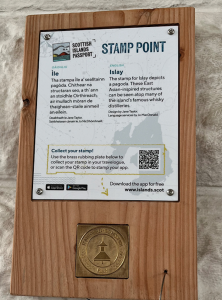
Sarah’s job-share partner was Kirsten Gow, who moved on late in 2022 to continue postgraduate studies in island migration. Her role is now taken by Katy Beasley, just getting her feet under the table, but also based on the Inner Hebridean island of Jura. Sarah says: “It’s a central part of the project’s ethos that the people who work with us – whether staff or freelancers – should be islanders, so that the people doing the work already understand the challenges and opportunities of island living.”
During the disruption of a pandemic and the subsequent impact on tourism, Sarah and Kirsten had time to develop the online app which would form part of the digital form of the passport, as well as to consolidate the central philosophy of the Scottish Islands Passport.
Sarah explains: “We’re really motivated by how frustrated we were with the way the islands were sometimes being marketed. Obviously there’s a place for different approaches, but we felt that we were seeing the Disneyfication of the islands and very little about the everyday experience of living here.
“The islands, over time, have developed a ‘brand’ of big, empty wilderness and vast, idyllic beaches seen on a good summer day. But we felt that was missing some of the best of the islands, like the Jura we ourselves enjoy a million times more in the winter. People come here for lots of different reasons and empty beaches and endless summer days are an attraction, but if there’s no community there won’t be any visitor experience, and the way the islands were being marketed was in danger of actually contributing to that.
“Of course the islands are beautiful, that goes without saying, but there’s a practical reason for focusing on people and businesses. It is, after all, the people who actually live and work here who make the place special. One doesn’t cancel the other out, but it’s not all about wilderness and emptiness.”
There was another motivation, too, to creating a new route for visitors to learn about possible island destinations, and that was in geographical diversity. Sarah said: “Most people who talk about visiting Scottish islands talk about Arran, Skye, Mull – which are lovely places. But there are 72 inhabited Scottish islands which you can access by regular transport and so many of them rarely get mentioned.”
To whet people’s appetites over the potential of a much wider range of experiences, the Scottish Island Passport is designed to act as a theme-based compass, pointing people at destinations that match their interests. The app was designed, populated with island residents’ experience and made live during lockdown, and since December visitors have been able to order the first of a developing series of physical, passport-sized travelogues. The first is on the theme ‘Meet the Makers’ – introducing a host of artisans, craftspeople and hands-on workers who are ready to share their skills.
By following your inclination, either geographically or on a specific theme, you can discover knitwear made in the northern Orkney island of Westray, willow woven on the Isle of Eigg or contemporary fused glass designs from Britain’s most northerly island, Unst in Shetland.
Once you arrive at an island you may have discovered before, or through your Scottish Islands Passport, you’ll be able to track down a physical passport ‘stamp’ engraved in bronze and prominently located. It’s not a treasure hunt – all the locations are listed on the website at https://islands.scot/stamps/. Designs come from local artists, and they’re being sited at one location on each island, so that passport holders can find them and create their own rubbings, either in their passport travelogue or in their own holiday journal.
Every stamp has a story, as exemplified by the stamp for Wyre in Orkney. Artist Alannah Norquay created the Wyre stamp design using a unique aspect of Wyre’s story, as told here in the Orkney dialect by Orkneyologist Tom Muir.
“The stamp fur Wyre shaas a burds-eye view o’ Cubbie Roo’s Castle. This owld stone biggeen wis said tae be the home tae the Orkney giant, whaur’s fame is weel kent a’ through the broken isles o’ Orkney.”
(The stamp for Wyre depicts a birds-eye view of Cubbie Roo’s castle. This old stone structure is said to have been home to the Orkney giant, who’s fame is well known throughout the Orkney isles.)
Stamp locations will eventually be present on every one of the 72 islands included in the passport scheme. With a local story, a physical stamp to rub into your log and a QR code to download the digital stamp, they create a link between the excitement of real-place discovery and the remote digital access that so many people now use to explore the world.
Creating these links does even more to explode the myth that Scottish islands are not only uniquely scenic, but also somehow backward-looking and stuck in the past. Sarah says: “People can have the idea that islands are backward and aged, but there’s something essential for me about how resourceful people need to be to do well on an island. It’s not ambitious enough to be sustainable, our places have to thrive, and I see that around me every day.
“It’s perhaps not so obvious to a visitor, but when I go into our little shop in Jura and there’s bread, I have an underlying awareness of how resourceful the people who run the shop have had to be, to make sure there’s bread. It’s not a given. In fact the shop is phenomenally well-stocked and the immense jigsaw puzzle of order and delivery schedules to make sure all the goods are there would give most shop-owners heart-failure.
“You generally find that islanders are quite humble about how good they are at things, so their resourcefulness and creativity goes under the radar a bit. You won’t immediately see how much innovation goes into everything. The story about islands getting older and declining is true to an extent, but in Jura our population has gone up by 30% in five years and that’s mostly among young families. The islands are buzzing with new ideas and innovations, so the view that islands are trapped in the past doesn’t hold.
“What islanders are very well able to do – and it’s hard to articulate for marketing – is to hold the past and the future in balance. They can remember heritage, families, places, culture, but they can also innovate and be forward-thinking. Island communities are able to see those two aspects of life as mutually compatible, in the same way that beaches and weather do go together with people and life.
“Living here you are naturally more attuned to weather, landscape and the way things have always been, but it doesn’t stop you from looking forward. Island communities can straddle those two truths.”
You can find out more about the Scottish Islands Passport scheme at https://islands.scot. And follow businesses highlighted on these pages at https://lismoreluminations.com, https://ngraved.co.uk and https://hoxatapestrygallery.co.uk
Dawn Siegel, N-Graved, Mainland Shetland
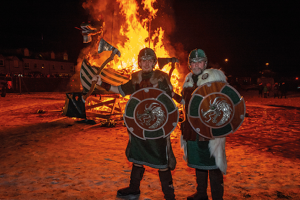
Since she was two years old, Shetland has been home to Dawn Siegel, whose family settled there after following the ancient Viking sea-roads from the Outer Hebrides. She’s entirely absorbed the culture of her island home, and now her precision engraving in wood and metal is intrinsic to the fearsome Jarl Squads as they prepare for the annual winter festival of fire, Up Helly-aa. Axes, shields and other armaments worn and carried by the Jarls are adorned with Dawn’s work and the Viking tradition also informs her own designs for gifts, custom-engraved keepsakes and commercial plaques.
Dawn describes herself as self-taught, and a busy wife and mum of four. She says: “I have worked hard on building my business over the last 11 years and have added more machines and equipment to open up more options for my customers. Everything I make is handcrafted and finished, using a variety of machines with some hand engraving too. My work is very much inspired by Shetland, home to our family. The Shetland dialect and words are so distinct and I never tire of hearing it. It’s one you can recognise instantly, even if you happen to be on the other side of the world, and often brings about conversations. Shetlanders are very proud of their dialect.”
With her unique blend of skills and island location on Mainland Shetland, Dawn was a natural choice to make the brass passport ‘stamps’ which are now being put in place all over the islands.
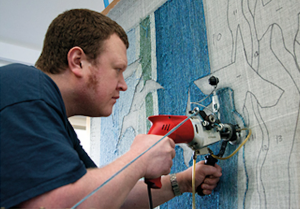
Hoxa Tapestry Gallery, South Ronaldsay, Orkney
The Hoxa Tapestry Gallery is a family business run by local artist Jo Thomson, her brother Andrew and father Benny. Her mother Leila, the founder of the gallery, who passed away in August 2022, graduated in tapestry from Edinburgh College of Art in 2010, returning home to Orkney to work. Leila’s three older sisters – including jewellery designer Sheila Fleet – and two nieces also went to Edinburgh College of Art, making Jo the seventh member of their family to study there.
The gallery was built in 1996, originally to exhibit Leila’s unique handwoven tapestries. Jo grew up weaving alongside her mother, her own artwork combining handwoven tapestry and painting. All the gallery’s artwork is inspired by the rhythm of life and landscape of Orkney. Andrew, Jo’s brother, makes the gallery’s picture framing and in the winter months makes handcrafted rugs from Jo and Leila’s drawings.
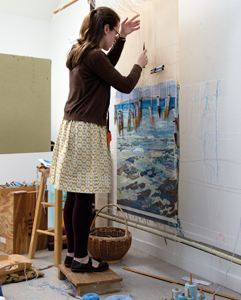
Demonstrating the continuation of ancient links between islands groups, their businesses uses Shetland wool for both rugs and handwoven tapestries. It comes to them from traditional suppliers like the 224-year old JC Rennie and Co of Aberdeenshire, Jamieson’s of Shetland, founded in 1893 and still spinning Shetland wool and Jamieson and Smith of Lerwick who buy 80% of the wool clip in Shetland. It’s a virtuous circle, passing business between companies with their own history and island connections.
Andrew said: “We think the Scottish Islands Passport is a good idea to get people oot and exploring the smaller islands. A lot of people do the North Coast 500 and stop at John O’ Groats, not realising we are here, and visitors to Orkney tend to focus on archaeology, but we’re hopeful of seeing some improvement, especially in international visitor numbers, next year.”
In April 2022, the gallery provided the host venue for the official launch of the Scottish Islands Passport, with tourism minister Ivan McKee on the spot to give a welcome to the new initiative.
The pictures show Andrew and Jo at work with some of the most recent rug designs and tapestry artworks at the Hoxa Gallery.
Lismore Luminations, Croic Ur, Isle of Lismore
Hazel MacCormick of Lismore Luminations is deeply inspired by her island landscape, and by the almost magical power of aromas to evoke moods and memories. She returned home with her husband John to his family’s native island 15 years ago, bringing a young family and building a home next door to her farmer in-laws. with a change of circumstances in 2015 she needed to find a flexible business which could be run from home and, having always had a passion for fragrance, set up Lismore Luminations as a kitchen-table business with an honesty box at the end of the drive.
She says: “Very soon the honesty box got bigger, and I ended up building a workshop between lockdowns, which were a creative time in themselves. I was making care packages with handwash and sanitiser in them, which said ‘until we meet again, stay safe’. People loved them and the business flew from there. We are so fortunate to live on the tranquil island of Lismore and to be inspired by the nature and beautiful surroundings of the island. Every candle is made with cocoanut and rapeseed wax, infused with premium fragrance oils and hand poured in small batches in our island workshop.”
Hazel’s candles, diffusers, wax melts and handwashes change with the seasons from sea-salty and tangy to floral and bright. Some of the wintry favourites are hard to describe. We might expect the Captain’s Quarters to smell a little ripe, but in fact the fragrance is summed up as: “Smooth and smoky, a sophisticated scent accented by warm tobacco tones, topped by sweet rum and zesty citrus fruits and a base of leather. Wonderfully winter.”
Hazel works hard over winter promoting her company at markets and fairs around the west coast and highlands, so she’s very familiar with the complex logistics of getting products to and from the islands. She says: “We had a craft fair we were going to this year in Appin where five of the eight makers were from Lismore, but the weather forecast was bad, so we weren’t even sure we would make it.”
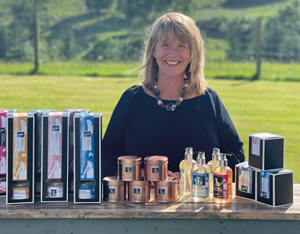
They got there OK, and the relationship they have with the ferry services to and from the islands is a fine example of island practicality. Haze has had times when, to get products to a fair, she has had to ship a car load over on one ferry and return without her car on the passenger-only foot ferry. She’s pleased to give credit to those who help her along the logistical journey. She said: “You always get service with smile on the Lismore Oban ferry with CalMac Ferries finest, Kenny and John.”
Three separate invitations to display at John Lewis proves that small island makers can take their place with the best on the high street, however small their island home. She said: “They try to support young businesses so they have someone different for a pop-up shop every week, but after I had my turn in 2021 they had a cancellation, so they invited me back again and I have had a week in 2022 as well.”
When one business on the island does well, everyone benefits. Hazel sources the engraved wooden lids for her luxury range from a quirky little design company called Seahorse, also on Lismore, and during the busy time over Christmas she has a part-time employee to help out with acking and despatch. with that, a family thriving on her business proceeds and a strong island connection, she’s building Lismore’s future.
Photo from Lismore Luminations.



